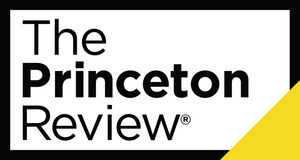The Princeton Review Releases Its Free Downloadable "Guide To 353 Green Colleges: 2015 Edition"
- Lewis & Clark College Takes #1 Spot on New List of "Top 50 Green Colleges"
NEW YORK, April 16, 2015 /PRNewswire/ -- As the nation gears up to celebrate Earth Day on Wednesday, April 22, The Princeton Review (www.princetonreview.com) today released its sixth annual free guide to the most environmentally responsible "green" colleges.
The Princeton Review's Guide to 353 Green Colleges: 2015 Edition profiles colleges with the most exceptional commitments to sustainability based on their academic offerings and career preparation for students, campus policies, initiatives, and activities. The profiles in the guide give college applicants information about each school's admission requirements, cost and financial aid, as well as student body facts and stats.
The free 218-page guide is downloadable at www.princetonreview.com/green-guide. There users can also peruse detailed "Green Facts" write-ups on the schools. The write-ups report on everything from the school's use of renewable energy, recycling and conservation programs to the availability of environmental studies and career guidance for green jobs.
New to the 2015 edition is a ranking list of the "Top 50 Green Colleges" on which Lewis & Clark College (Portland OR) captured the #1 spot. Among its many green distinctions: 100% of the college's electricity is generated by "green power" sources; the college has reduced its greenhouse gas emissions by more than 30% since 2006, and the Lewis & Clark Green Energy Institute develops projects that advance and support renewable energy policies.
"Among nearly 10,000 teens who participated in our 2015 College Hopes & Worries Survey, 61% told us that having information about a school's commitment to the environment would influence their decision to apply to or attend the college," said Robert Franek, The Princeton Review's Senior VP-Publisher. (A complete report on that survey is at www.princetonreview.com/college-hopes-worries.) "We strongly recommend the schools in this guide to environmentally-minded students who seek to study and live at green colleges."
Franek noted compelling facts about the top 50 colleges on the guide's new ranking list. Among this group of schools:
- 33% of their total food expenditures go to purchases of local and/or organic food
- 81% of the new construction on their campuses is USGBC (www.usgbc.org) LEED-certified
- 96% offer an undergraduate major or degree that is sustainability focused
- 98% have a sustainability officer and sustainability committee
The top 15 schools on The Princeton Review's "Top 50 Green Colleges" list are:
- Lewis & Clark College (OR)
- Green Mountain College (VT)
- University of California, Santa Barbara
- State University of New York-Stony Brook University
- Dickinson College (PA)
- Cornell University (NY)
- American University (DC)
- College of the Atlantic (ME)
- Middlebury College (VT)
- University of Vermont
- Portland State University (OR)
- Colorado State University
- Willamette University (OR)
- University of Washington
- Pomona College (CA)
The complete list of top 50 schools is at www.princetonreview.com/green-guide. Information about how The Princeton Review chose the schools for the guide and tallied its top 50 green colleges ranking list follows.
How Schools Were Chosen for the Guide
The Princeton Review chose the colleges based on "Green Rating" scores (from 60 to 99) that the company tallied in summer 2014 for 861 colleges using data from its 2013-14 survey of school administrators. The survey asked them to report on their school's sustainability-related policies, practices, and programs. More than 25 data points were weighted in the assessment. Schools with Green Rating scores of 83 or higher made it into this guide. Most of the schools (347) in this edition are in the U.S. Five are in Canada. One is in Egypt. Information about Princeton Review's Green Rating and its Green Honor Roll saluting schools that received the highest possible rating score, 99, is at www.princetonreview.com/green-guide. Note: The Princeton Review does not publish the schools' Green Rating scores in this guide. The scores can be found in the profiles of the schools on www.princetonreview.com and in the 2015 edition of The Princeton Review books, The Best 379 Colleges and The Complete Book of Colleges, published in August 2014.
How the Top 50 Green Colleges List Was Done
The Princeton Review developed the ranking list using data from its institutional survey for its Green Rating and its surveys of students attending the colleges. Ten data points from the institutional survey were factored into the assessment. Data from the student survey included student ratings of how sustainability issues influenced their education and life on campus; administration and student support for environmental awareness and conservation efforts; and the visibility and impact of student environmental groups.
The Princeton Review first published this guide in 2010. It remains the only free, annually updated downloadable guide to green colleges. The company is also known for its dozens of categories of college rankings in its annual books, The Best 379 Colleges and Colleges That Pay You Back.
About The Princeton Review
The Princeton Review is a leading test preparation, tutoring, and college admission services company. Every year, it helps millions of college- and graduate school-bound students achieve their education and career goals through online and in person courses delivered by a network of more than 4,000 teachers and tutors and its more than 150 print and digital books published by Penguin Random House. The Princeton Review is headquartered in Natick, MA, and is an operating business of IAC (NASDAQ: IACI). For more information, visit The Princeton Review on its web site and on its Facebook page. Follow the company's Twitter feed @ThePrincetonRev.
WEBSITE
www.princetonreview.com/green-guide
SOURCE The Princeton Review
Related Links
http://www.princetonreview.com
WANT YOUR COMPANY'S NEWS FEATURED ON PRNEWSWIRE.COM?
Newsrooms &
Influencers
Digital Media
Outlets
Journalists
Opted In





Share this article